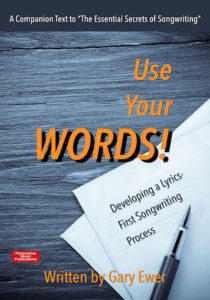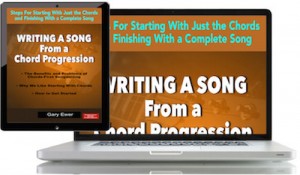 FREE with the Bundle purchase: “Use Your Words! Developing a Lyrics-First Songwriting Process” shows you how to put lyric-writing front and centre in your songwriting process.
FREE with the Bundle purchase: “Use Your Words! Developing a Lyrics-First Songwriting Process” shows you how to put lyric-writing front and centre in your songwriting process.
Do you find that your songwriting gets stuck at the chord progression stage? When this happens, it’s usually attributable to a common misunderstanding about chords: the need for chords to be unique. You’re probably aware of a hilarious video by the Axis of Awesome that showcases dozens of songs that all use the same chord progression. Though they make the point with humour, it’s actually true: you can write unique songs by using already-used progressions.
I’m not suggesting that you give up your search for a great progression, but coming up with something that hasn’t been done before is almost, if not completely, impossible.

“Writing a Song From a Chord Progression” is an eBook (high quality PDF format) that describes the best way to write songs by starting with chords. A must-read for those who like the chords-first approach. Part of the Deluxe “The Essential Secrets of Songwriting” Bundle package.
And the fact is, one of the most important characteristics of chord progressions is the fact that on some level, they need to be at least a bit predictable. This is not a weakness, it’s a feature.
So if you simply want to get going writing something, and you don’t want to spend all day finding chords that work, try these 7. They’re the kind that you can repeat over and over again, and they form a really nice sequence that audiences will love:
- E B C#m A – This is the “Axis of Awesome” progression that accompanies so many songs. It works because it incorporates strong 4ths and 5ths movements of the roots, from E to B, and from A back to E. The C#m acts as a little “deceptive cadence” moment.
- E A G#m A B E – Try this one by holding each chord for 2 beats, with the G#m being held for 4. The G#m is a iii-chord, which is actually not all that common in pop music.
- C G/D C/E F G F/A G/B C – A great progression that results in an upward-moving bass scale.
- C G/B Am Am/G F C/E Dm7 C – A harmonized descending bass line.
- C A7 D7 G C – A progression that uses “secondary dominant chords”. Basically, whenever you change a chord that’s usually minor (in the given key) into a major one, and follow it with a chord whose root is a 4th higher, you’ve created a secondary dominant.
- C G/B Am F Fm C – The Fm in this progression is called a “modal mixture”, and adds a nice melancholy flavour to your song.
- Dm7 G7 Cmaj7 Fmaj7 Bm7(b5) E7 Am7– A really nice jazz sequence.
Numbers 3 and 4 work nicely in partnership with each other. If you choose to follow 3 with 4, try replacing the final C chord with a G or G7.
A lot of what makes chord progressions work centres on the issue of strong versus fragile progressions. Here’s a video I did recently that explains that concept:
________________
Written by Gary Ewer, from “The Essential Secrets of Songwriting” website
Follow Gary on Twitter for notification of website updates and daily songwriting tips
“The Essential Secrets of Songwriting” e-book bundle will show you how to write great songs, harmonize your melodies, and give you hundreds of chord progressions in the process.
PURCHASE and DOWNLOAD the e-books for your laptop/desktop











Great insights on these chord progressions! In my own songwriting, I’ve been experimenting with them, and they really do provide a solid foundation. I can’t wait to try out some of your examples!
Great insights on these chord progressions! I’ve been experimenting with them in my own songwriting, and they really do provide a solid foundation. Can’t wait to try out some of the examples you provided!
Hi Gary,
Great article and thank you for writing it. I write a newsletter for home studio hobbyist musicians and I referenced this article in the latest issue where I talk about using chord progressions for creative inspiration when my energy is low.
You can see the latest copy of that newsletter with your article in it here: https://pages.musicmakernews.com/5_1_20
Thanks again for the great article!
Pingback: 7 Chord Progressions That Work All the Time – Jazz Improvisation Materials & Concepts
I think progression number four sounds much better with a G or G7 at the end instead of a C. This leads naturally back to the C at the beginning.
The progression is also a bit more interesting if the Dm7 is switched to a D7 as this is out of the key of C and provides contrast and a dominant chord to lead to the G7 previously mentioned.
Hi Joe:
The purpose of that progression was to create a descending bass line, hence the Dm7-C at the end.
-G
Please, when do we use slash chords on piano….. I meant how can I improvise using slash chords
The most common use of slash chords (inversions) is to smooth the transition from one chord to the next. So for example, if your progression is C F G C, you could insert an inverted chord between the first C and the F (and cut the time value of the C chord to make that work, of course). So you’d wind up with: C C/E F G C.
To improvise using slash chords, the best first step is to ignore the slash chords, and get a progression that works well just as a series of root position chords. Once that’s working, and you’ve been improvising on some good ideas, you can begin to add in some inversions to smooth out the bass line.
It’s possible, in that regard, to worry too much about slash chords. Slash chords don’t change the function or use of chords — they simply add colour to an already-working progression.
-Gary
Nicely done in simple practical fashion. Thks
brilliant information and so easy to understand. I would willingly buy your ebooks but I am in the uk and have never bought from the usa before. would I need to pay tax etc?
many thanks.
Hi Steve:
I’m very pleased that you like the blog. Regarding the eBooks, no, there is no tax for sales to UK citizens. The price is converted by PayPal from US dollars to Pounds (which today is, I believe, around 24.33.
Cheers!
-Gary
I am a retired kindergarten teacher. My classroom was magical because of my beloved puppets, favourite children’s books and MUSIC. I am not an expert musician ( guitar, accordian, Grade 6 piano) but most kiddie writers just use traditional tunes with new words (ugh). Is kinder music dumbed down because children’s brains haven’t developed a broader musical range or is it because teachers have so much curriculum to prep that a CD of simple nursery songs is a quick method of “covering” the subject. In the infinite world of composition I think (hope) there can be new tunes for kiddies. Keeping in mind that kiddie music does not have big tone jumps or complicated rhythms what do you think?
It’s what parents think is acceptable since the early 2000’s. Simple, dumbed down music only sets the standard and doesn’t raise comprehension.
Pingback: Learn The Popular Song Chord Progression - Piano Tutorial for Popular Songs - Block Buster Song
Great post, thanks! Do you have examples of songs that fit into the other 6 chord progressions listed above? (Since you already mentioned #1 was similar to all of the Axis of Awesome songs)
Reblogged this on jonathan ditto music .
Am/g is a g with a 9 11 and 13
Hi James:
No, that’s not correct. When naming chords, you need to take into account not just the chord tones, but also the note that is acting as the root. G13 (the one you describe) is a dominant chord, while Am/G (technically called vi/4-2) is a passing chord that takes the Am on to F. So even though G13 (G-A-C-E) uses the same notes as Am/G, their functions are different, as are their roots.
-G
Hi Gary, love your site! Explanations are very clear and accessible. I have a question about progression 4 above. I assume the key for the progression is C Major, so I don’t understand what Am/G means. Am has notes A-C-E, so how does a “/G” inversion work with this? I’ve played it as a straight G2 under A3-C3-E3, but it doesn’t fit well in the progression. When I tried Am, G as the progression it sounded better (at least to my untrained ear!)
Thanks in advance for any advice.
That might have been better described as Am7/G, with the G being the 7th of the chord. But in general, any note after a slash should be the note in the bass, no matter what the chord is. So for example, the middle chord in this — Bb F/Bb F — means an F chord with a Bb in the bass, even though there is no Bb in the chord part.
I quite like the Am/G as a nice passing chord between Am and F. But of course, choosing chords is a matter of taste — all part of what makes music so individual and so interesting!
-Gary
Pingback: Chord progressions | Pghboemike's Blog
This is great stuff! Very much appreciate your sharing these ideas…no on to practice!
Mr Gary EWER, i must confess that you doing noble by the lessons you have put up for our development,may God bless you!
I agree to that apostle Joseph I think these chords will help me as a person to write songs so god bless Gary
On the topic of inversions or slash chords, you’ve said there should be a reason behind choosing to use an inversion. What might an example be? As a guitar player, i tend to like the sound of a full, six string chord, so I often play the 3rd fret of the low E string (a G note) when playing a C chord instead of simply muting the string. As a lousy but aspiring piano player, i sometimes choose inversions to minimize the amount of moving around the keyboard i have to do if i’m singing at the same time. I go by my ear as far as deciding what and when inversion work, but generally speaking, are those “reasons” along the lines of what you’re talking about?
Hi Charlie:
One of the reasons for using inversions is the one you mention, which is to minimize how much your bass line would move around, especially on a piano. In other words, to prevent an overly-jumpy bass line. related to that is the use of inversions to create more interesting stepwise bass lines.
The other reason for chord inversions is to provide some chord interest. In other words, if you’re strumming a C chord over and over again, moving to C/E after a few strums of C can provide a more interesting progression.
Regarding the issue of inversions as you mention it on guitar, keep in mind that an inversion happens when the lowest-sounding pitch is not the chord root. So on guitar, you may be playing C/E, but if there is a bass instrument playing with you who is still playing the lower C, then it means that an inversion isn’t actually occurring. Inversions require you to take the entire instrumentation into account.
Hope this helps,
-Gary
Excuse me but what do the slashes mean? Do they mean you play each chord for half the length of chords without the slash? Thanks
When a chord has a slash, it means that the letter name before the slash is the chord you play, and the letter name after the slash is the bass note. So the chord ‘G/D’ that you see in the third progression means play a G chord, keeping the note D as your lowest note in the lefthand of a piano part, or in the bass. Those are called ‘slash chords’, or inversions. (The progressions will technically work fine even if you play just the letter name of the chord, without worrying about the slash part.
-Gary